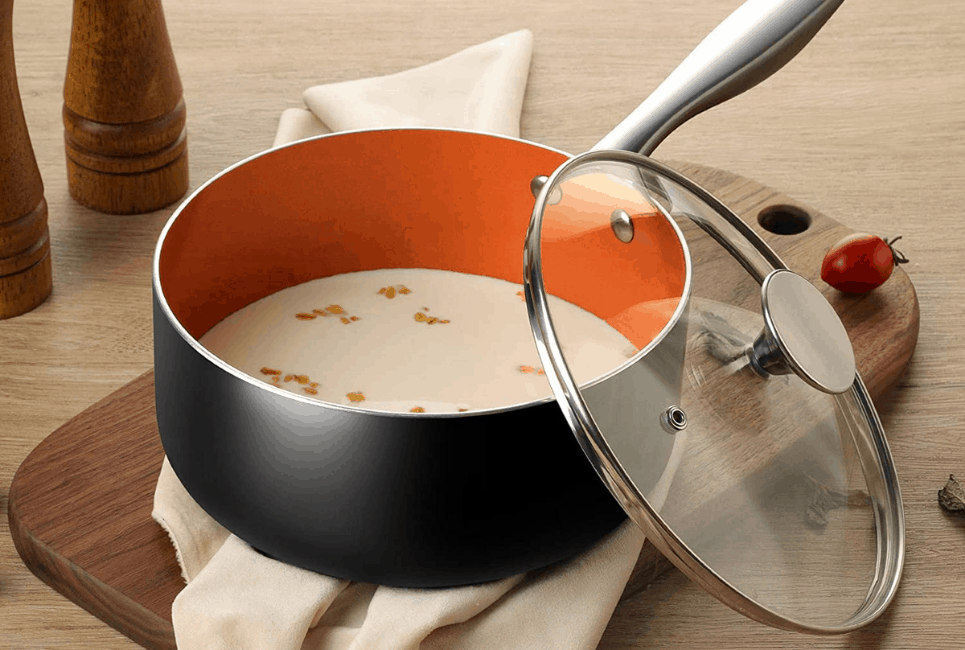- Frymaster Parts Guide - December 31, 2021
- Best Vulcan Fryer Guide For The Commercial Place - November 26, 2021
- Robot Coupe Food Processor Model Guide - November 16, 2021
Is it time to upgrade your kitchen? Have you been looking for the best commercial saucepans for your new restaurant? Well, you are in luck because we have put together a list of the best commercial saucepans on the market.
Choosing a saucepan can seem like a daunting task. With so many different materials and brands to choose from, it is no wonder that people often feel overwhelmed when they go shopping for one. Commercial saucepans are a staple in any commercial kitchen. But how do you find the best commercial saucepan for your needs?
Made from a variety of materials including copper, aluminum, and stainless steel, the best material for your needs will depend on what type of food is being prepared in it.
Our guide will give you all of the information that you need when making this important decision. We cover everything from what type of material to look for, to frequently asked questions about commercial sauces pans. Let’s dive right in!
Saucepans And Their History

Have you ever wondered how our cookware evolved from stone and turtle shells to beautiful enamelware, cast iron, and stainless steel? It all started with the saucepan!
Saucepans are one of the earliest cooking vessels, dating back to around 300 BC. Early versions were made out of stone and turtle shells – yes, really! And strangely enough, even the best commercial saucepans today still have a long way to go before they can beat these early cookware choices in terms of durability.
The word ‘sauce pan’ is thought by some scholars to come from an old French phrase meaning “a pot for making sauces”. Other historians believe that it may be derived from two Greek words: saus (meaning soup) and panna (meaning vessel). This makes sense when you consider what was typically cooked in this utensil back then – soups and stocks.
The earliest ceramic pottery discovered was used in China and Japan and dates back to 25000-29000 BCE. Metallic copper tools weren’t used until around 9000 BCE and historians do not know when copper cookware first appeared, but it has been extensively documented.
The Egyptians and the Greeks used copper pots; however, there is little documentation about this practice beyond these civilizations. The Romans are believed to have started using both bronze and copper in their glass melting operations as well as on their cooking utensils—including saucepans.
From there, we developed cast iron, dutch ovens, and skillets. Long handles on cookware were replaced with shorter ones, and materials like aluminum, Teflon, stainless steel, glass, and stoneware were used more commonly in kitchens.
What Are The Different Types of Saucepans?
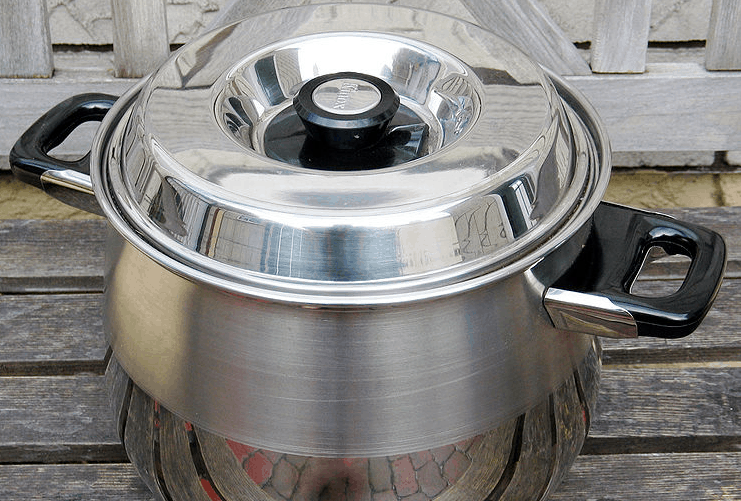
Commercial saucepans can come in a variety of shapes and sizes, with the most common being round or oval-shaped. Here are a few of the most common types of saucepan:
Stockpot
A stockpot is a large, round-bottomed saucepan used to prepare stocks. It is typically larger than a regular pot and has very high sides that allow stock ingredients to simmer without spilling over the side of the pan. It is typically used to cook liquid foods that do not necessarily need to be really close to the heat source.
In a commercial stockpot, you can saute and brown ingredients like meat, or vegetables like onions or carrots, before adding your liquid and leaving to simmer.
They are ideal for making soups, stews, casseroles, mince dishes like chili con carne or shepherd’s pie, or even for keeping pasta submerged while boiling. Stockpots come in a range of sizes but are typically made from stainless steel.
Saute Pan
Saute pans are deep and have low, sloping sides that allow for easy stirring. These pots are ideal for sauteing, a technique that involves quickly cooking food while in motion but covered with a lid. They are similar in look to a frying pan, but, where a frying pan will have sloping sides, a saute pan will have straight ones. Saute pans also come with a lid.
They come with a metal or wooden handle to make them easier to grasp while cooking. Saute pans are best suited for simple dishes like eggs, omelets, fried rice, stir-fries, or steaks. In commercial kitchens, they can also be used as an alternative roasting pan, or to deep-fry, sear, or prepare certain sauces. These saucepans typically come in stainless steel or aluminum nonstick versions.
Saucepan
A saucepan is typically deeper than a sauté pan and has taller sides that don’t slope downward towards the bottom of the pot; this makes them unsuitable for stovetop searing purposes but perfect for sauces because of the depth. Saucepans can be used with or without a lid to control the evaporation rate, and are a must-have in every commercial and household kitchen.
They are best for cooking sauces, boiling pasta, making oatmeal, or simmering stews and soups. Saucepans come in a range of sizes but they typically have one long handle.
Saucepot
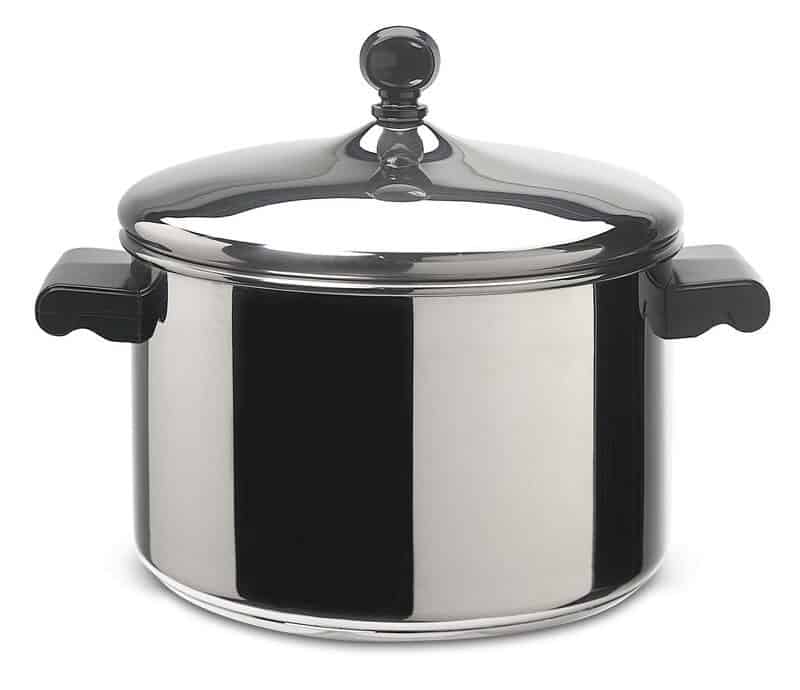
Similar to a saucepan, a saucepot is designed for cooking sauces. Saucepots are best used with a lid and come in a range of sizes that can vary from small to large pots. However, the main difference between a saucepan and a saucepot is while a saucepan has only one long handle, a saucepot has two handles on either side of the pot.
Saucepots are best suited to produce sauces like béchamel or spätzle, and they can also be used for cooking pasta. In commercial kitchens, a saucepot is best used for restaurant dishes that need whisking such as hollandaise sauce.
Pressure Cooker

A pressure cooker is typically used for cooking stews and soups that are made in a large quantity. This type of pot comes with two handles, one on either side of the pan, and has an airtight seal. It also contains a safety valve to release excess pressure inside when necessary.
A pressure cooker works by increasing the boiling point of liquid so it can cook food quicker than if you were using another method like steaming or poaching. This makes it perfect for commercial uses such as restaurants where there’s often a need to produce large quantities of food at once.
Particularly because they’re best used with moist ingredients like vegetables and meat stocks versus dry ones like rice or pasta; this means steam production is increased which speeds up the cooking process.
Dutch Oven
The best Dutch ovens (also known as brazier pans) are large, lidded pots that come in a range of sizes and can be used on the stovetop or in the oven. They usually have two loped handles and are made out of an oven-proof material like stainless steel, copper, or a combination of clad metals.
They are best suited for slow-cooking meats or stews but they also have many other uses such as braising meat and vegetables before adding them to your dish, making soups, and cooking casseroles.
Dutch ovens work best with moist ingredients because it allows steam production which increases cooking time without having to use higher heat levels. The shape is deep enough to hold water for poaching, but shallow enough that it can evaporate, intensifying any cooking liquids. This is perfect if you’re looking for an even distribution of moisture throughout your meal – especially when combined with long-cooking recipes where there’s no need to stir constantly.
When you are looking for a brazier pan, it is important that the base be heavy so heat will not escape. You’ll also want a tight-fitting lid so the heat stays in, and so you can control evaporation for best succulence.
Cookware Set
A cookware set is best for chefs who want to have the basics at their fingertips. You’ll typically find a range of saucepans, sauté pans, and frying pans in these sets that are ideal for chefs who would rather buy everything at once than shop for lots of different pans. One set usually contains most of the basics that chefs need to get started.
Buying cookware as a set can also make things much more convenient in terms of storage as the set usually slots together quite nicely. It will also contain the most versatile tools possible that can be used for a variety of different cooking methods and with various types of ingredients.
Cookware sets can contain both commercial-grade pans or pans suited for home use, so make sure you’ve done your research before you buy.
What to Look For in a Commercial Saucepan
So, before you jump straight into buying the perfect commercial saucepan, what do you need to look for? Here are a few things to consider:
Material
The best commercial saucepans are usually made from copper, aluminum, stainless steel, or clad metals. Each type offers different benefits related to durability and versatility. It is also important to consider whether the material will be ovenproof.
Size
You will want to think about how many people you will usually be cooking for and choose a size best suited for your needs. The best commercial saucepans are usually between six and twelve inches in diameter, but they can come as small as three or four inches if you’re cooking just one portion at a time. It’s probably best to purchase a range of sizes for your restaurant so that you have a wider choice.
Price
Commercial saucepans range from $20 to over $500, so you will want to shop around for the best price available. You should also consider your needs when it comes to budget and see if there are any pans that best suit those specifications. In this case, cookware sets might actually end up being more affordable.
Features
Some commercial saucepans come with features like copper finishes or a glass lid which may increase cost depending on where you purchase them.
Maintenence
When you’re buying a commercial saucepan, it’s best to take into consideration how easy it will be to keep clean and look after it. Copper and clad metals can be more expensive but they are also easier to clean because their stainless-steel layers prevent foods from sticking or burning onto them.
This is best for any cooks who want pans that will last long periods of time without discoloration. Copper and aluminum are best suited for chefs who cook at high heat levels because it heats up quickly and evenly disperses the heat.
Stainless steel is best when you want a pan that will not discolor or react with acidic foods like tomatoes, which can leach onto your cooking surface over time and ruin its finish in the process. No matter which type you choose to buy, it is important that you consider whether you want an oven-safe material so your pans will last longer and not warp or change shape over time from exposure to high heat levels.
Weight
Some commercial saucepans can be incredibly heavy. This is particularly the case if they are made from stainless steel or copper because these materials usually best fit the needs of commercial chefs. Cooks who want pans that will be easier to transport should consider an aluminum, clad metal, or cast-iron pan instead.
Types of Food You’ll Be Cooking
There are a variety of cooking methods that best suit the types of material you buy. Copper and clad metal pans (mentioned above) best fit commercial kitchens because they heat up quickly, evenly distribute heat, and clean easily. They are best for chefs who cook at high temperatures like sautéing or frying vegetables with oil. Stainless steel best suits cooks who cook with artificial heat sources like electric stoves and microwaves.
Cooks should also consider if they will be cooking acidic foods, which can react with copper and discolor the material over time. Cast iron best fits cooks that want pans that are both durable and versatile for a variety of different types of food preparation.
Durability
These materials you choose will likely offer a variety of benefits based on durability and versatility. It is important to consider whether the material will last longer with exposure to high heat levels and not warp over time.
Commercial Cookware Material Types
Let’s take a deeper dive into some of the most popular types of material used to make commercial saucepans:
Stainless Steel
Stainless steel is one of the most popular materials used in commercial kitchens. It’s great for chefs who cook with artificial heat sources like electric stoves because it adequately handles temperature changes. It is also best if you are cooking acidic foods, which can react with copper or aluminum and discolor the material over time.
Aluminum
Another of the most popular materials in cookware, aluminum is an excellent conductor of heat and allows heat to spread evenly throughout the pan. Aluminum best suits cooks who cook at high temperatures like sautéing or frying vegetables with oil.
The metal is dishwasher safe, harder than steel (so much more durable), and fairly affordable to buy. However, untreated aluminum should not be used to cook acidic foods because it can react with the material and discolor it over time.
Carbon Steel
This material best suits chefs who want pans that are both durable and versatile for a variety of different types of food preparation. It’s best for those cooking with gas or electric heat, which will allow the metal to heat up quickly and evenly distribute the flame across its surface.
It can be both expensive and inexpensive, depending on the brand and type of saucepan you are purchasing, and maintains its temperature very well. It’s most commonly used with woks and stir-fry pans, but can also be found in saucepans.
Cast Iron
This thick, heavy-duty saucepan material is durable and versatile. Cast-iron can take a while to hear up but distributes the flame very evenly across its surface.
The downside is that it is not dishwasher-safe and cannot soak in water for long periods of time because cast iron is prone to rusting if it’s exposed to water for a while. This means they are slightly more high-maintenance to clean.
Cast-iron saucepans come in two varieties: bare iron and enamel coated:
- Bare Cast Iron: Bare cast iron is a heavy, durable material that is able to withstand high heat levels. It must be seasoned before use and won’t take on any color or seasoning otherwise. However, these types of pans are prone to rust if exposed to water for long periods of time due to their porous surface, meaning they must be cleaned by hand.
- Enamel Coated Cast Iron: Enamel-coated cast iron has all the benefits of bare iron, but it is coated with an enamel coating to prevent it from rusting. As such, it requires less maintenance and cleaning, but some foods will not cook on this type of cast iron, and acidic foods may strip off the coating.
Tri-Wall Pans
Tri-wall pans, which are made out of a series of three layers: metal and two sheets of insulation that provide better heat retention than other materials. They distribute the flame evenly throughout the saucepan but can’t be used with induction stoves.
The best part is that they are ovenproof and can withstand high heat levels in the dishwasher. They are also less prone to warping over time as their metal layers will not react with food, a concern for cooks who work at high temperatures like frying or sautéing vegetables in oil.
Ceramic

If you want a stove-top saucepan that isn’t as heavy and durable but also a great insulator, then ceramic is a winner. It’s typically used for casserole dishes or small saucepans, and is lighter but more fragile, than cast iron.
Porcelain
Porcelain best suits cooks who want a lightweight, beautiful, and easy to clean material. It is also dishwasher safe and can usually be used on the stove, in the oven, or in a microwave. The porcelain coating is white, as it helps to contrast the color of sauces and spices in your pot. There are two types of porcelain:
- Stoneware: Stoneware is fired to become really hard and uses a different type of clay, so it comes in other colors as well as white.
- Earthenware: Earthenware is porous, but it’s better for serving ware as opposed to cookware. This is because it’s weaker and more prone to chipping and cracking.
Copper
Copper is best for when you want to cook food that needs very high heat, like searing or cooking delicate fish. It’s the best conductor on this list and provides incredibly even heating.
Copper has one major downside, however: if copper isn’t lined on the inside with stainless steel, then it can react with acidic foods and turn them black and toxic. It’s also quite a high-maintenance material. It can react with food, discolor, needs regular polishing, and can also scratch easily.
Nonstick
Nonstick is technically a coating as opposed to the actual material, but it’s a good choice for cooks who don’t want to be scrubbing their saucepans all day. It won’t react with food and is a great way to cook healthy dishes because you don’t need to use much, or any, fat.
It’s also incredibly easy to clean. It is often used in conjunction with many other metals on this list, however, the downside is that it can be easily scratched, so you’ll need to use rubber or silicone utensils on this surface.
Clad
Clad best suits cooks who want pots and pans with an easy-to-clean surface that doesn’t require much oil or butter to cook. Stainless Steel is usually a mixture of clad and aluminum, which takes the thickness and conductivity of the aluminum and corrosion resistance of the clad. However, as a downside, it’s usually quite heavy and very expensive.
The Major Differences Between Stainless Steel vs Aluminium Saucepans
Basic cookware types that chefs rely on include aluminum, stainless steel, and nonstick. Despite being used for the same tasks in a kitchen, it is best to know the differences between these saucepans before investing your money.
Aluminum is best for people who want to cook at high levels of heat, like when searing or cooking delicate fish. Aluminum saucepans are ideal for commercial cooking due to their lightweight, inexpensive cost, and excellent heat conduction.
Stainless steel is typically made from a combination of metals like carbon, iron, and chromium, occasionally with small traces of copper. The stainless steel exterior on the outside of the saucepan should be at least two millimeters thick. It’s best for cooks who need a durable saucepan that can withstand high levels of heat with minimal warping.
Stainless steel is great for both commercial, home, or restaurant kitchens because it can go from the stovetop into an oven up to 500˚F without any problem.
Advantages of Stainless Steel Saucepans
- Better for cooking with high temperatures – stainless steel is great for searing, poaching, or frying foods and especially good for meats like steaks and chicken.
- Aesthetic value – stainless steel best suits cooks who want a durable and aesthetically pleasing saucepan.
- Requires little maintenance – for cooks who don’t have time to polish their cookware, this material is great.
- No reaction with food – as long as the pan does not have a copper lining, it will be safe to cook acidic foods in it without fear of contamination or discoloration.
- Durability – stainless steel saucepans are extremely durable, versatile and you can use them to cook pretty much anything.
- No coating – they don’t typically have a coating (unless you go for a non-stick version), which means they can be used with any utensils and there is less worry about them getting scratched.
- Any cooktop – you can use stainless steel with any type of hob including an induction hob.
Disadvantages of Stainless Steel Saucepans
- They cool slowly – stainless steel has poorer conduction, meaning they cool down quite slowly compared to other saucepans.
- Expensive – it can be a pretty pricey material, especially for the larger, heavier models.
- Heavy – stainless steel is usually heavier than aluminum. In fact, with stainless steel, heavier is often better with better quality brands having a thicker base, so this is something to take into account.
The Advantages of Aluminum Saucepans
- Excellent heat conductors – great for searing, poaching, or frying foods, aluminum will both heat up and cool down very quickly.
- Lighter than stainless steel – aluminum is a good choice if you want lightweight pans compared to other materials on the market.
- Inexpensive to buy – usually aluminum is considerably less expensive than stainless steel or cast iron.
The Disadvantages of Aluminum Saucepans
- Can leak metal flavor – this is especially true in acidic food like tomato-based sauces. If you’re considering buying aluminum cookware, buying it pre-treated is essential.
- The metal taste can also end up in food when you’re whisking foods such as dairy products or sauces.
- Buckles easily – aluminum can buckle under high heat, especially if it is too thin.
- Not usable on induction hobs – aluminum pots and pans cannot be used on an induction burner because the cookware does not contain enough nickel.
Commercial Saucepan Best Use Tips
- Take care of your cookware and it can last a very long time.
- Don’t put non-dishwasher-safe saucepans in the dishwasher.
- Try not to use a dishwasher at all when possible. High-temperature water can both loosen the handles over time and damage the surface of your saucepans.
- Ensure pans have properly cooled down before exposing them to cold water. Going straight from very hot to very cold temperatures can warp and even crack saucepans.
- Salting cold water when you’re cooking can pit the surface of your cookware. Always add salt when the water is boiling.
- Remove calcium building by mixing 3/4 cup water and 1/4 cup vinegar and boiling in your saucepan.
- Stains that can’t be removed usually come from overheating the pan. You can usually remove them with vinegar or acidic foods like tomatoes or lemons.
- Always keep an eye on your pans when the heat is up really high to prevent them burning and food being burnt onto the bottom.
- Hand-dry your pans properly to remove watermarks and smears from the metal.
- Using non-abrasive cleaning tools will help preserve your saucepans. Scourers can damage the surfaces and scratch the pans.
- Always use silicon, wooden, or plastic utensils on non-stick coating because otherwise, it can scratch off and damage.
Our Commercial Saucepan Recommendations
Vogue Tri Wall Saucepan 3Ltr
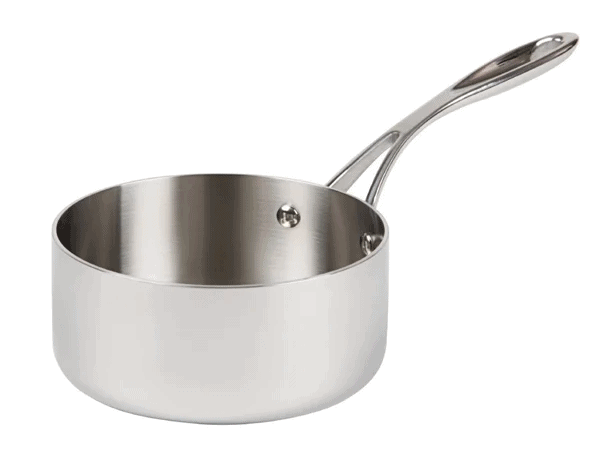
This Vogue Tri-Wall heavy-duty saucepan features a special layered construction that will provide you with the best cooking results possible.
One of the top brands in cookware, Vogue Kitchen Products originated from Denmark but has been operating in America since 1950. They pride themselves on providing quality products for your everyday needs and this saucepan is no different.
This high-quality saucepan has an aluminum core that is evenly distributed between stainless steel walls. The saucepan is perfect for all manners of catering.
Pros
- 3-liter capacity
- Aluminum thermocore distributes heat evenly
- Dishwasher safe
- Can be used on induction hobs
Cons
- The lid isn’t included in the price
Vogue Casserole Pan 13Ltr
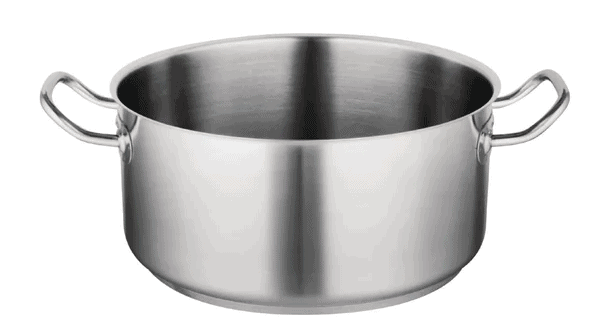
This saucepan from Vogue has a depth of 14 centimeters, making it perfect for cooking stews, casseroles, and other liquid foods. This saucepan is made with high-quality stainless steel. Each of these features a stay-cool handle so that it’s easy to carry the contents and the pan won’t end up burning your hands.
Pros
- 14cm depth can hold up to 13 liters
- Made from high-quality stainless steel
- Suitable for cooking on all cooking surfaces including inductions hobs
Cons
- The lid isn’t included in the price
Vogue Stock Pot 56.7Ltr

Cook large quantities of food to perfection with this large stock pot available from Vogue. The aluminum pot retains heat well and transfers heat quickly, but it’s also lightweight enough that you can carry it around with little effort.
The pot consistently cooked stocks, soups, and other dishes every time, and the wide opening and handles make it easy to stir and keep it steady while you cook.
Pros
- Huge 56.7-liter capacity
- High-quality aluminum retains heat well
Cons
- Not dishwasher compatible
- Doesn’t come with a lid
De Buyer Inocuivre Copper Saucepan 3.3Ltr
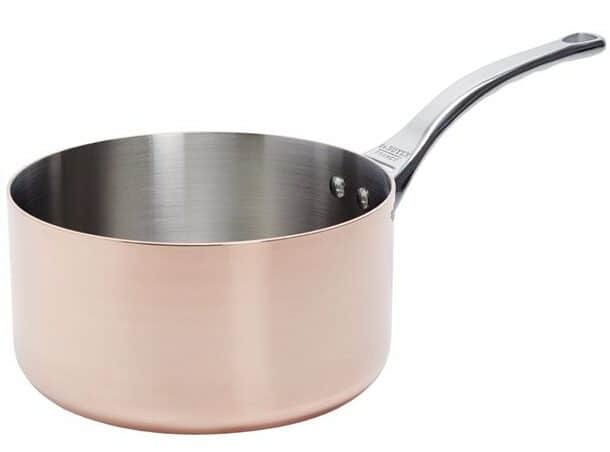
This De Buyer Inocuivre Copper Saucepan is a large saucepan with an attractive cast stainless steel handle and non-stick inner lining made of stainless steel.
This combination of materials offers a variety of advantages, including excellent heat conduction. Chefs can braise and brown all types of ingredients. These saucepans are also perfect for a wide range of other tasks, including sauteing vegetables and making sauces.
Pros
- 3.3-liter capacity
- Attractive copper design
- Stainless steel lining means you won’t have to replate this model
Cons
- Not suitable for dishwashers
- Can’t be used on induction hobs
- Expensive
Circulon Momentum Hard Anodised Aluminium Saucepan 3.8Ltr
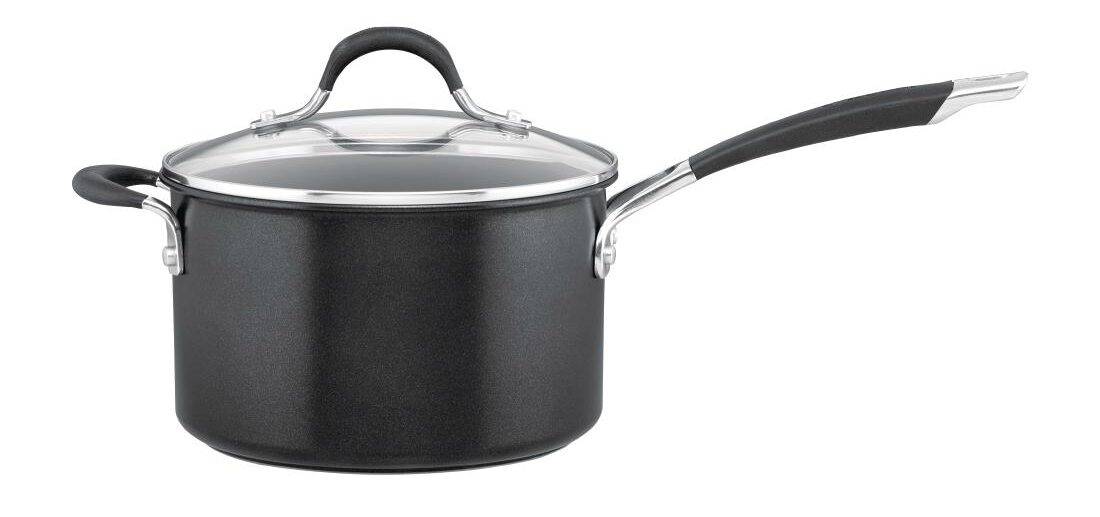
This aluminum 3.8-liter saucepan from Circulon is an excellent choice for any chef, whether they are cooking at home or in a commercial kitchen. This saucepan is suitable for use on induction hobs and can be cleaned in dishwashers and the large, comfortable handle makes this pan easy to grip, lift and move around.
This Circulon Nonstick Total System will make cooking even easier, as food won’t stick to it and it’ll be super simple to wipe clean. It also comes with a lifetime guarantee for the ultimate peace of mind.
Pros
- Large 3.8-liter capacity
- Total® hi-low non-stick system
- Induction suitable base
- Lifetime guarantee
- Comes with a lid
Cons
- You may need to use special utensils to protect the non-stick base
FAQs
Question: How do you use a saucepan?
Answer: Saucepans come in many sizes and shapes. They usually have a long handle for easy handling, but you don’t need to use the handle if you’re just cooking on the stovetop. You can also put them in the oven. To use, simply add a little fat to the bottom, put the hob on the stove, turn on the heat, and add your ingredients.
Question: How do I care for my saucepan?
Answer: In order to best maintain your saucepan, you should always use wooden, plastic, or silicone utensils on non-stick coatings and best avoid dishwashers. Make sure that pans have cooled before exposing them to very cold water because this can result in the warping/cracking of your saucepan. Clean your saucepans after every use with soap and warm water.
Question: How do you keep stainless steel pans from sticking?
Answer: You can make your own non-stick coating on stainless steel pans to prevent foods from sticking. Do this by heating oil to a high temperature and when it starts to simmer, remove it, cool it down, wipe it with a cloth, and it should have a non-stick coating. This is called seasoning the pan.
Question: How do I clean my pots?
Answer: All that’s needed to keep your best commercial saucepans looking brand new is a little elbow grease and some dish soap. Make sure to dry them thoroughly if they have watermarks or smears that won’t come off in order to best maintain the condition of your pans.
Question: What should I be aware of when choosing the best commercial saucepans?
Answer: You want something durable, easy to clean, affordable, and best suited to your cooking needs.
Question: What kind of pans do commercial kitchens use?
Answer: Commercial restaurants and caterers usually use commercial-grade best saucepans, which can be found in restaurant supply stores or online. These pans are often much thicker than home cookware as they need to withstand a lot of wear and tear from high-volume cooking. They are usually made from aluminum or stainless steel.
Question: What are the best quality saucepans?
Answer: The best commercial saucepans are those that can withstand a lot of wear and tear, whether it’s in your kitchen or in a restaurant. Stainless steel is usually best for high-volume cooking because it doesn’t react with food as aluminum does. Aluminum pans often come lined with nonstick coatings to reduce messes but they’re more likely to warp or break.
Question: How do I store commercial saucepans?
Answer: In order to best maintain your best commercial saucepans, make sure they’re not exposed to cold temperatures and are properly dried after use. You can also hand-wash them with dish soap when needed. The best place to store pans is in a cabinet away from the stove.
Question: Why do chefs not use non-stick pans?
Answer: Chefs avoid non-stick saucepans because they are usually quite delicate. they require certain utensils, can scratch or get damaged easily, and are not always dishwasher safe, which is not exactly what you want in a busy kitchen environment.
Best Commercial Saucepan: Final Thoughts
When it comes to the best commercial saucepans, there are a lot of things you’ll want to keep in mind. In this blog post, we’ve explored the best commercial saucepans on the market, what to look for when choosing a commercial saucepan, including durable material like stainless steel or aluminum; easy-to-clean pans; affordable prices; and suitability in cooking needs.
When it comes down to it, there’s no one right answer or one type of pan that’s better than the others–it all depends on your own personal preference and what your catering establishment is cooking! Happy shopping.

